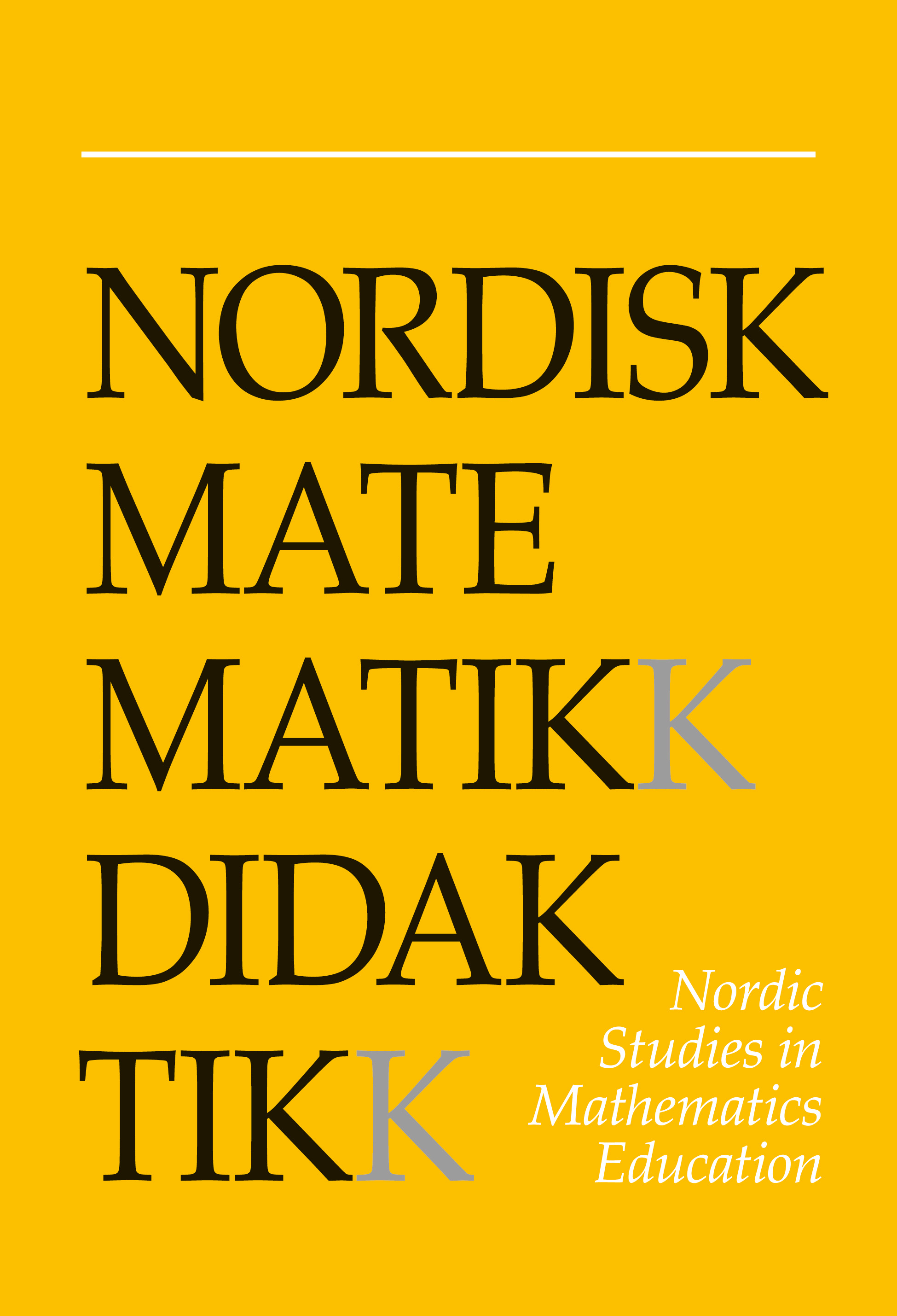Different views – some Swedish mathematics students’ concept images of the function concept
DOI:
https://doi.org/10.7146/nomad.v15i4.148286Abstract
This study analyses what kind of concept images a group of engineering and teacher students have of the function concept, and how these concept images are related to the historical development of this concept. The study was conducted using questionnaires, and 34 students at a Swedish university participated. It is found that the students primarily rely on operational conceptions of the function concept, with only a minority of students possessing structural conceptions. The definitions given by the students mostly resemble an 18th or 19th century view of functions. The study also indicates that the character of the definitions given in the textbooks used by the students affect their concept images.
References
Adams, R. (2006). Calculus: a complete course. Toronto: Pearson Addison Wesley.
Akkoç, H. & Tall, D. (2002). The simplicity, complexity and complication of the function concept. In A. D. Cockburn & E. Nardi (Eds.), Proceedings of the 26th conference of PME (Vol. 2, pp. 25-32). Norwich: University of East Anglia
Akkoç, H. & Tall, D. (2005). A mismatch between curriculum design and student learning: the case of the function concept. In D. Hewitt & A. Noyes (Eds.), Proceedings of the 6th British Congress of Mathematics Education (pp. 1-8). London: British Society for Research into Learning Mathematics.
Attorps, I. (2006). Mathematics teachers' conceptions about equations (Research report 266). Department of Applied Sciences of Education, University of Helsinki.
DeMarois, P. & Tall, D. (1996). Facets and layers of the function concept. In L. Puig & A. Gutierrez (Eds.), Proceedings of the 20th conference of PME (Vol. 2, pp. 297-304). University of Valencia.
Eisenberg, T. (1992). On the development of a sense for functions. In C. Harel & E. Dubinsky (Eds.), The concept of function: aspects of epistemology and pedagogy (MAA Notes 25) (pp. 153-174). Washington: MAA.
Even, R. (1990). Subject matter knowledge for teaching and the case of function. Educational Studies in Mathematics, 21 (6), 521-544. https://doi.org/10.1007/BF00315943
Even, R. (1993). Subject-matter knowledge and pedagogical content knowledge: prospective secondary teachers and the function concept. Journal for Research in Mathematics Education, 24 (2), 94-116. https://doi.org/10.2307/749215
Gray, E. & Tall, D. (1994). Duality, ambiguity and flexibility: a "proceptual" view of simple arithmetic. Journal for Research in Mathematics Education, 25 (2), 116-140. https://doi.org/10.5951/jresematheduc.25.2.0116
Hansson, Ö. (2006). Studying the views of preservice teachers on the concept of function. Department of mathematics, Luleå University of Technology.
Kleiner, I. (1989). Evolution of the function concept: a brief survey. The College Mathematics Journal, 20 (4), 282-300. https://doi.org/10.1080/07468342.1989.11973245
Meel, D. (2000). Prospective teachers' understandings: function and composite function. Issues in the Undergraduate Mathematics Preparation of School Teachers: The Journal, 2000 (1), 1-12.
Norman, A. (1992). Teachers' mathematical knowledge of the concept of function. In C. Harel & E. Dubinsky (Eds.), The concept of function: aspects of epistemology and pedagogy (MAA Notes 25) (pp. 215-232). Washington: MAA.
Petterson, K. (2008). Algoritmiska, intuitiva och formella aspekter av matematiken i dynamiskt samspel. En studie av hur studenter nyttjar sina begreppsuppfattningar inom matematisk analys. Department of Mathematical Sciences, University of Gothenburg.
Repo, S. (1996). Matematiikkaa tietokoneella. Derivaatan käsitteen konstruoiminen symbolisen laskennan ohjelman avulla (Joensuun yliopisto. Kasvatustieteellisiä julkaisuja 33). University of Joensuu.
Rodhe, S. & Sigstam, I. (2000). Naturlig matematik. Skebobruk: Kub.
Rüthing, D. (1984). Some definitions of the concept of function from Joh. Bernoulli to N. Bourbaki. The Mathematical Intelligencer, 6 (4), 72-77.
Sfard, A. (1991). On the dual nature of mathematical conceptions: reflections on processes and objects as different sides of the same coin. Educational Studies in Mathematics, 22 (1), 1-36. https://doi.org/10.1007/BF00302715
Sfard, A. (1992). Operational origins of mathematical objects and the quandary of reification - the case of function. In C. Harel & E. Dubinsky (Eds.), The concept of function: aspects of epistemology and pedagogy (MAA Notes 25) (pp. 59-84). Washington: MAA.
Sierpinska, A. (1992). On understanding the notion of function. In C. Harel & E. Dubinsky (Eds.), The concept of function: aspects of epistemology and pedagogy (MAA Notes 25) (pp. 25-58). Washington: MAA.
Tall, D. & Bakar, M. (1991). Students' mental prototypes for functions and graphs. In F. Furinghetti (Ed.), Proceedings of the 15th conference of PME (Vol. 1, pp. 104-111). Assisi: PME.
Tall, D. & Vinner, S. (1981). Concept image and concept definition in mathematics with particular reference to limits and continuity. Educational Studies in Mathematics, 12, 151-169. https://doi.org/10.1007/BF00305619
Vinner, S. (1992). The function concept as a prototype for problems in mathematics learning. In C. Harel & E. Dubinsky (Eds.), The concept of function: aspects of epistemology and pedagogy (MAA Notes 25) (pp. 195-213). Washington: MAA.
Vinner, S. & Dreyfus, T. (1989). Images and definitions for the concept of function. Journal for Research in Mathematics Education, 20 (4), 356-366. https://doi.org/10.2307/749441
Downloads
Published
How to Cite
Issue
Section
License

This work is licensed under a Creative Commons Attribution-NonCommercial-ShareAlike 4.0 International License.



